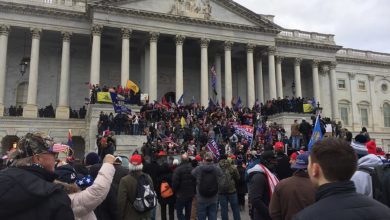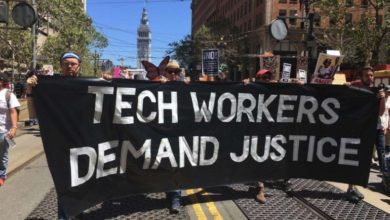Photo: Background photo: TapTheForwardAssist on Wikipedia via CC Attribution-Share Alike 4.0 license. Arm and phone: Image by Free-Photos from Pixabay
Originally posted Jan. 18 on Tech for the People.
In the wake of the storming of the U.S. Capitol building and attempt to interrupt the certification of Joe Biden as the 46th President, a predictable refrain has been repeated amongst politicians and law enforcement. “We need new anti-terrorism laws,” they say. “We need more freedom to surveil people,” they shout.
Biden himself is in favor of such a proposal. He spent much of his weak, meandering campaign pushing the idea of a new domestic terrorism law and working to “re-professionalize” the Department of Homeland Security, according to the Wall Street Journal in 2020.
Much of Jan. 6 was plotted out in the open
It was no secret that the far right, including fascist forces, were planning to rally in D.C. on Jan. 6. Members of the Proud Boys, followers of the QAnon conspiracy theory and other general MAGA-types were openly promoting the event for at least a month on social media sites like Twitter, Facebook and the now-defunct Parler.
On Dec. 21, writer Arieh Kovler posted on Twitter:
On January 6, armed Trumpist militias will be rallying in DC, at Trump’s orders. It’s highly likely that they’ll try to storm the Capitol after it certifies Joe Biden’s win. I don’t think this has sunk in yet.
— @ariehkovler on Twitter
A fundraiser on DonorBox raised over $183,000 of their $40,000 goal from 2,172 donations with the language, “We the people must take to the US Capitol lawn and steps and tell Congress #DoNotCertify on #JAN6″
Rep. Marjorie Greene posted on Parler, “On January 6 on the House floor, I will OBJECT to fraudulent electoral votes from several states at the Capitol. But I cannot do this alone. I must have a grassroots army behind me.” While she went on to tell people to sign petitions, the language is a clear call to action.
A search on Twitter for ‘storm Capitol Jan 6’, only showing tweets from December 2020, reveals an endless stream of posts about actions at the U.S. and various state Capitols, including explicitly-named “Storm the Capitol” rallies in multiple states. Calls to bring weapons and prepare for death were widespread. And of course Donald Trump himself incited the action: “Big protest in D.C. on January 6th. Be there, will be wild!”
On the day itself, participants livestreamed video on Parler. ProPublica gathered and reviewed thousands of videos and has published an impressive interactive story with video from around D.C., near the Capitol and inside the Capitol from 12 p.m. to 6 p.m.
Deep surveillance wasn’t needed
The U.S. government has massive surveillance tools at its disposal. The NSA can intercept data or metadata about phone calls, text messages, email, web browsing and messages. It built massive tools to track communications and map social networks. Its offensive weapons can infiltrate networks and devices without being noticed. Stingray devices are deployed at events and used to track phones, which can be tied back to their owners. They infiltrate groups and chats.
Private companies often assist the state in these efforts. Over 2,400 police use Clearview AI’s facial recognition software. Companies like Babel Street and Ventel now build software for analyzing networks and communications. Geofence warrants can be used to identify anyone who was in a particular area at a specific time.
It’s become clear that the Capitol Police, some Congresspeople and other government officials were in on the plot to various extents.
The participants in the fascist coup attempt doxxed themselves. They planned openly on Parler, Gab, Twitter, Facebook and other networks. They livestreamed their acts — including the killing of a Capitol police officer — to the world. They didn’t wear masks. And yet, the FBI is now practically begging the public for information about those who stormed the Capitol. The participants and instigators, up to and including Donald Trump, should be arrested and tried.
It wouldn’t have taken deep network analysis or breaking into devices to find out the plans for Jan 6. A Twitter search would have done it.
The predictable calls for new and improved surveillance measures must be countered. The tools already at the state’s disposal would have been more than enough: a Twitter search provides plenty of incriminating evidence. This is not a new phenomenon. Throughout the history of the U.S., federal and local agencies have regularly taken advantage of violence or unrest to increase their own power.
CIA creates CHAOS in the 60s
As protests against the Vietnam War and movements for Black liberation spread, the CIA developed a number of domestic and international surveillance programs. With college campuses being a hotbed of progressive and revolutionary activity, including significant solidarity actions with the Black Panther Party, the CIA merged multiple projects under the name CHAOS. According to former CIA operative Verne Lyon:
As campus antiwar protest activity spread across the nation, the CIA reacted by implementing two new domestic operations. The first, Project RESISTANCE, was designed to provide security to CIA recruiters on college campuses. Under this program, the CIA sought active cooperation from college administrators, campus security, and local police to help identify antiwar activists, political dissidents, and “radicals.”
The History of Operation CHAOS
The second was Project MERRIMAC, which provided information about protests against the CIA.
Using its partnerships and gathered information, agents “began in earnest to pull off burglaries, illegal entries, use of explosives, criminal frameups, shared interrogations, and disinformation” against their targets on campus, including student magazines.
DEA’s ‘War on Drugs’ and phone records
In 1992, the Drug Enforcement Administration began what could be considered the precursor to the NSA’s mass phone surveillance program. Under the leadership and with the authorization of then-Attorney General William Barr (who is also Trump’s current Attorney General), one of the DEA’s new programs stored call records of all calls from the U.S. to countries deemed by the DEA to be a “nexus of drugs” from the early 90s through 2013. In 2014, the DEA switched to “issuing subpoenas to one or more telecommunications service provider(s) for telephone metadata,” according to a report from the Office of the Inspector General that found the DEA “failed to conduct a comprehensive legal analysis” of its “use of its administrative subpoena authority to collect or exploit bulk data.”
This bulk data included billions of metadata records of calls. A targeted surveillance program would gather information about a specific person or phone number. Bulk collection makes the target secondary, enabling the collecting agency to retroactively search the records for information. While the specific list of countries may not be known, the DEA often targets countries in Southeast Asia, and Central and South America, adding to the already racist nature of the War on Drugs.
1996 Anti-Terrorism bill suggests advanced surveillance
In the aftermath of the 1993 World Trade Center and 1995 Oklahoma City attacks, Congress passed — and Bill Clinton signed — the Antiterrorism and Effective Death Penalty Act in April of 1996. The most concerning aspects of the law were tightened restrictions on habeas corpus — the basic right of a person to challenge their own imprisonment. The AEDPA imposed serious restrictions on the ability of federal judges to grant habeas petitions and effectively removed the opportunity to make multiple such petitions.
The law also included two sections directly related to electronic surveillance. Title VIII, Subtitle A, Sec. 810, “Study and report on electronic surveillance” called for the Attorney General and FBI to study the legality of wiretaps and then to provide a report with justifications for expanding that authority.
Title VIII, Subtitle B, Sec. 821, “Research and development to support counterterrorism technologies” provided up to $10 million in 1997 to develop new surveillance and tracking technologies.
Then-Senator Joe Biden vigorously supported and defended AEDPA and helped shape some similar legislation that had failed to get traction.
9/11 and the omnipresent surveillance state
Passed in the weeks and months after 9/11, the USA PATRIOT ACT and Authorization for Use of Military Force Against Terrorists shaped the future of the National Security Agency’s mass surveillance.
The aspects of the NSA’s programs since 9/11 are pretty well-known, thanks in great part to whistleblowers like Mark Klein, Bill Binney, Edward Snowden and many more.
In 2004, Klein outlined how the NSA monitored phone traffic through an AT&T building in San Francisco. Behind a nondescript door in Room 641A, massive amounts of advanced equipment split the fiber optic lines coming into the building and captured internet traffic for the NSA. Programs like FAIRVIEW and TITANPOINTE utilize AT&T buildings across the country to intercept phone and internet traffic.
Revealed by Edward Snowden in 2013, PRISM is potentially the most infamous NSA program. It required explicit cooperation with internet companies like Google, Apple, Facebook, Microsoft and many others. NSA analysts could use a simple interface called XKeyscore to search for communications to or from anyone, including “real-time” internet activity.
Oppose new state surveillance
Even before Jan. 6, Joe Biden was calling for new “domestic terrorism” legislation in response to the rising tide of white nationalist groups inspired by Trump. His statement the day after furthered this push.
Responses to significant violence — or even threats of it — targeted at the state often result in increased surveillance. That surveillance is never limited to its supposed targets, and the categorization of those targets themselves is often based in racist or anti-communist rhetoric.
The panopticon of mass surveillance seems inescapable: the mass of three-letter agencies in conjunction with private internet providers, phone companies and internet services attempts to watch every step we take and every purchase we make. They trade information for financial or political benefit, rarely putting up a legal or PR fight.
Yet, there is hope. Individual whistleblowers, journalists and researchers filing FOIA requests and reviewing government documents provide the information we need to organize movements in defense of our civil liberties. It’s up to the rest of us to build and mobilize these movements, educating our class on what’s happening and how we can fight it, and ultimately winning our rights.





